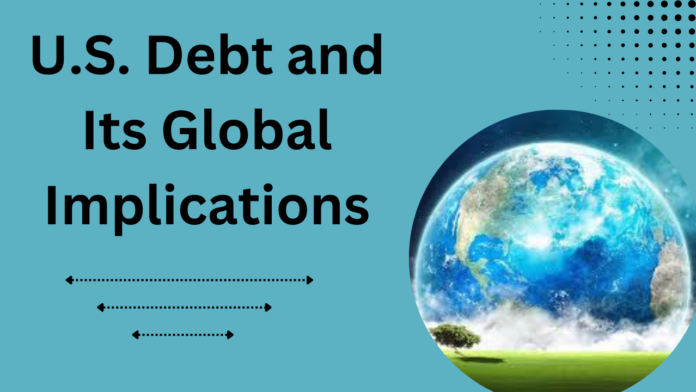Introduction to U.S. Debt
The U.S. debt has been a hot topic for years, sparking debates among politicians, economists, and everyday citizens alike. With numbers soaring into the trillions, it’s hard to ignore its implications not just for America but for the entire globe. As we delve into this complex issue, we’ll uncover what drives our national debt higher and how it reverberates through global markets. From fiscal policies to monetary strategies, understanding these dynamics is crucial in today’s interconnected world. Are you ready to explore the causes and consequences of U.S. debt? Let’s dive in!
Causes of U.S. Debt
The causes of U.S. debt are multifaceted and deeply rooted in economic policies. One major contributor is government spending, often driven by programs such as social security, healthcare, and military expenditures. These essential services require substantial funding.
Tax cuts can also play a significant role. When revenue decreases without corresponding reductions in spending, the budget deficit increases, leading to higher national debt.
Economic downturns further exacerbate this issue. During recessions, tax revenues plummet while demand for social services rises sharply. This double whammy forces the government to borrow more money.
Additionally, political gridlock complicates fiscal policy decisions. Disagreements on how best to manage budgets result in delayed actions that could mitigate rising debts.
Global financial obligations add another layer of complexity. As international commitments grow, so too does the necessity for borrowing domestically to meet these demands.
Impact on the Global Economy
The U.S. debt has far-reaching implications for the global economy. As one of the world’s largest economies, fluctuations in its financial health ripple across borders.
When the U.S. borrows extensively, it can lead to higher interest rates globally. Countries that depend on American imports may find their costs rising, ultimately affecting consumer prices everywhere.
Moreover, a significant rise in debt can provoke fears about default or inflation. This uncertainty prompts investors to seek safer assets, often leading to volatility in stock markets worldwide.
Emerging economies are particularly vulnerable. They rely heavily on foreign investment and trade with the U.S.; disruptions here could stifle growth prospects.
Additionally, shifts in monetary policy aimed at managing this debt can have unexpected consequences abroad, affecting currency values and international trade balances as nations adjust their strategies accordingly.
How Other Countries are Affected
The U.S. debt doesn’t just impact Americans; it sends ripples across the globe. Countries holding substantial amounts of U.S. Treasury bonds can face significant risks when debt levels rise uncontrollably.
For instance, nations heavily reliant on exports to the United States may see demand falter if American consumers tighten their belts due to rising interest rates linked to increasing national debt. This could lead to slower economic growth in those countries.
Moreover, emerging markets often look towards the U.S. for investment and stability. A shaky fiscal landscape might deter foreign investments, creating a cycle of uncertainty that affects local economies.
Currency values are also at play here. If investors lose confidence in the dollar’s strength because of escalating debt concerns, it could lead to currency volatility worldwide, impacting trade balances and inflationary pressures globally.
Potential Consequences for the U.S
The rising U.S. debt poses serious risks domestically. As the national debt swells, interest payments consume a larger portion of the federal budget. This could lead to cuts in essential programs like education and healthcare.
Inflation may also become a concern as more money is printed to cover debts. A weakened dollar might follow, impacting consumers who rely on imports for goods.
Additionally, confidence in U.S. financial stability can waver among investors and other countries if debt levels continue unchecked. This could elevate borrowing costs and hinder economic growth.
Political instability often arises during debates about fiscal versus monetary policy approaches to manage this crisis effectively. Disagreements over spending priorities could deepen divisions within Congress, complicating decision-making processes further.
These factors jeopardize not only economic prosperity but also America’s standing on the global stage as a reliable leader in finance and trade.
Solutions to Reduce U.S. Debt
Addressing U.S. debt requires a multifaceted approach. One effective strategy involves revisiting fiscal policies to ensure balanced budgets. This means prioritizing essential spending and cutting unnecessary expenditures that contribute to wasteful government spending.
Increasing revenue through tax reform can also play a crucial role. Streamlining the tax code, closing loopholes, and ensuring corporations pay their fair share may generate significant funds for debt reduction.
Encouraging economic growth is vital too. By investing in infrastructure and education, the government can foster innovation and productivity, leading to higher revenues over time.
Moreover, controlling healthcare costs could alleviate financial strain on federal programs like Medicare and Medicaid. A focus on preventive care might mitigate expenses long-term.
Implementing transparent budgeting practices will hold officials accountable while fostering public trust in government spending decisions. These combined efforts could pave the way toward meaningful reductions in national debt without sacrificing essential services or growth opportunities.
Conclusion: The Importance of Addressing U.S. Debt for a Stable Global Economy
Addressing U.S. debt is crucial for promoting a stable global economy. The implications of high national debt extend far beyond American borders, affecting international financial markets and economies. Countries around the world watch closely as the U.S. navigates its fiscal challenges.
With an unstable debt situation, confidence in the dollar can wane, leading to fluctuations in trade relationships and investments globally. Other nations are often left grappling with the ripple effects of U.S. monetary policy changes and fiscal decisions.
By tackling national debt effectively through strategic policies and sensible spending practices, not only does it benefit Americans but also fosters a more secure economic environment worldwide. Prioritizing sustainable solutions will pave the way for future growth while safeguarding against potential crises that could harm both domestic interests and foreign partners alike.
The path forward requires collaboration between policymakers to balance fiscal versus monetary policy wisely, ensuring sound governance without unnecessary waste or reckless spending habits. As we move ahead into uncertain times, focusing on reducing national debt stands out as a vital step toward long-term stability—one that recognizes our interconnectedness in this increasingly complex global landscape.


